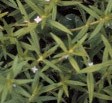 Unlike its close relative, Virginia buttonweed, Poorjoe is an annual and prefers a somewhat dryer site and greater distribution. It is a native of Eastern United States and is now found from New York to Florida, and across the Mid-west and Southwest to California. It grows in sunny to semi-shady sites with sandy soils and is common in sandhills, dunes, and pinelands.
Unlike its close relative, Virginia buttonweed, Poorjoe is an annual and prefers a somewhat dryer site and greater distribution. It is a native of Eastern United States and is now found from New York to Florida, and across the Mid-west and Southwest to California. It grows in sunny to semi-shady sites with sandy soils and is common in sandhills, dunes, and pinelands.
 Description: Poorjoe may be erect or spreading but is generally more erect than Virginia buttonwood. The stems are delicately branched, 4-18” long, occasionally hairy and may have a reddish tinge. The opposite, linear leaves lack petioles and have a membrane connecting each pair of leaves. They are ¾” to 1½” long, hairy, and have a distinct mid-vein. Small white to pink flowers with 4-6 petals are produced singly or in pairs in the leaf axils from summer to fall. Sepals with long hairs surround the petals. The seed pods consist of two nutlets and have three-four leafy wings on the top. The root is fibrous and shallow.
Description: Poorjoe may be erect or spreading but is generally more erect than Virginia buttonwood. The stems are delicately branched, 4-18” long, occasionally hairy and may have a reddish tinge. The opposite, linear leaves lack petioles and have a membrane connecting each pair of leaves. They are ¾” to 1½” long, hairy, and have a distinct mid-vein. Small white to pink flowers with 4-6 petals are produced singly or in pairs in the leaf axils from summer to fall. Sepals with long hairs surround the petals. The seed pods consist of two nutlets and have three-four leafy wings on the top. The root is fibrous and shallow.

 Control: Handpulling poorjoe is easy at any stage of growth because of its shallow root system. For severe infestations repeated applications of 2 or 3 way mixtures of dicamba, 2,4-D, MCPP and MCPA are effective.
Control: Handpulling poorjoe is easy at any stage of growth because of its shallow root system. For severe infestations repeated applications of 2 or 3 way mixtures of dicamba, 2,4-D, MCPP and MCPA are effective.